By Rupin Chopra and Shantam Sharma
Earlier this month we examined how the September 2025 GST reforms created direct consequences for LMPC (Legal Metrology Packaged Commodities) declarations, and how the notification of 9 September 2025 shaped the compliance roadmap[1].
The Ministry of Consumer Affairs has now issued a fresh notification dated 18 September 2025[2], which modifies and partly relaxes the earlier guidance. The change reflects industry representations that the original framework was too rigid for businesses carrying significant unsold stock or packaging material.
HIGHLIGHTS
| Area | 9 September 2025 Notification | 18 September 2025 Notification | Current Position |
| Revised MRP stickers | Permitted until 31 December 2025, with conditions | Voluntary for packages manufactured before 22 September 2025 | Stickers may be used but are not mandatory |
| Newspaper advertisements | Mandatory: at least two advertisements in newspapers, plus notices to dealers and regulators | Waived. Only circulars to wholesale dealers/retailers and regulators are required | Advertisement requirement removed |
| Use of old packaging material | Allowed until 31 December 2025 with corrections | Extended until 31 March 2026 | Packaging material may be used longer, subject to corrected MRPs |
A Softer Approach to MRP Stickers
The most striking change is that affixing revised MRP stickers on unsold stock is now optional. Businesses can choose to update packages manufactured before 22 September 2025, but there is no obligation to do so. If a sticker is applied, the original MRP must remain visible. This relaxation significantly eases the pressure on manufacturers with large inventories, where physically re-labelling each unit would have been impractical and costly.
Advertising Requirement Waived
Another burden has been lifted with the removal of the earlier requirement to publish newspaper notices about revised MRPs. Instead, manufacturers and importers now need only issue circulars to wholesale dealers and retailers, endorsing copies to central and state Legal Metrology authorities. This streamlined approach reduces expense while keeping traceability intact. In practice, it means price corrections will move faster through the supply chain without the delay or cost of press campaigns.
More Time to Use Old Packaging
The extension of the deadline for using pre-printed packaging material, from 31 December 2025 to 31 March 2026, acknowledges the realities of packaging procurement cycles. For businesses with significant stocks of printed wrappers, this additional quarter will prevent wastage and smoothen the transition to new packaging aligned with the revised GST rates.
Communicating with Consumers
Although the rules have been softened, the government has underlined that dealers, retailers and consumers must still be kept informed of price changes. Unlike the earlier prescriptive requirement of newspaper advertisements, the latest notification allows flexibility. Businesses can use electronic, print or social media channels to communicate revisions. The emphasis shifts from a rigid compliance formality to a broader obligation of transparency.
Clarification on Unit Sale Price
The advisory also clears up an area of uncertainty: declaring a revised unit sale price on unsold pre-packaged commodities or unused wrappers is not mandatory. If businesses wish to display revised prices voluntarily, they may do so, but failure to update does not attract liability. For companies worried about penalties for not reprinting every wrapper or label, this clarity is significant.
Conclusion
Taken together, the two September notifications chart a clear course. The initial 9 September framework established a strict compliance model, perhaps more suited to textbook application than industry realities. The 18 September update brings in pragmatism: physical re-labelling is not mandatory, newspaper advertisements are replaced by dealer circulars, and packaging material can be used longer.
For manufacturers and importers, the effect is to reduce costs and disruptions, while still requiring them to pass GST-related benefits or burdens through to consumers transparently. The shift places more responsibility on businesses to ensure retailers reflect correct prices and consumers are not misled, but it allows flexibility in how this is achieved.
[1] https://ssrana.in/articles/gst-rate-revisions-2025-and-their-impact-on-lmpc-declarations/
[2] https://www.pib.gov.in/PressReleasePage.aspx?PRID=2168208


